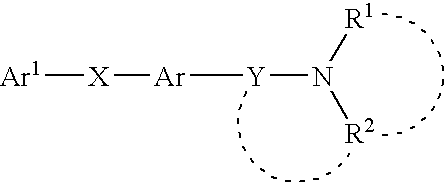Amine derivative
a technology of amine and derivative, applied in the field of amine derivative, can solve the problems of arthritis and pain, obesity becoming a social problem, and deviation from normal life support activities
- Summary
- Abstract
- Description
- Claims
- Application Information
AI Technical Summary
Benefits of technology
Problems solved by technology
Method used
Image
Examples
reference example 2
methyl 4-{2-[(tert-butoxycarbonyl)amino]ethyl}benzoate
[0451]
[0452] A solution (120 ml) of 3-[4-(methoxycarbonyl)phenyl]propionic acid (5.00 g, 24.0 mmol) obtained in Reference Example 1, triethylamine (4.34 ml, 31.2 mmol) and DPPA (6.21 ml, 28.8 mmol) in tert-butanol was stirred at 90° C. for 5 hrs, and the solvent was evaporated. Ethyl acetate was added to the residue and the mixture was washed with 10% aqueous citric acid solution, saturated aqueous potassium carbonate solution and saturated brine, and dried over anhydrous sodium sulfate. The solvent was evaporated under reduced pressure, and the obtained residue was purified by silica gel column chromatography (developing solvent; ethyl acetate:hexane=1:1), and powderized with hexane to give the title compound (2.46 g).
[0453]1H-NMR (DMSO-d6) δ: 1.35 (9H, s), 2.76 (2H, d, J=7.2 Hz), 3.17 (2H, m), 3.83 (3H, s), 6.90 (1H, d, J=5.4 Hz), 7.34 (2H, d, J=8.4 Hz), 7.87 (2H, d, J=8.4 Hz).
reference example 3
tert-butyl 2-[4-(1-pyrrolidinylmethyl)phenyl]ethylcarbamate
[0454]
[0455] To a solution (10 ml) of methyl 4-{2-[(tert-butoxycarbonyl)amino]ethyl}benzoate (550 mg, 1.97 mmol) obtained in Reference Example 2 in tetrahydrofuran was added lithium aluminum hydride at 0° C., and the mixture was stirred at room temperature for 1 hr. To the reaction mixture was added ethyl acetate and the mixture was washed with 0.5N hydrochloric acid and saturated brine, and dried over anhydrous sodium sulfate. The solvent was evaporated under reduced pressure, and the obtained residue was purified by alumina column chromatography (developing solvent; ethyl acetate) to give a colorless oil. To a solution (10 ml) of the obtained oil (495 mg, 1.97 mmol) and triethylamine (274 ml, 1.97 mmol) in dimethylformamide was added methanesulfonyl chloride (152 ml, 1.97 mmol) at 0° C., and the mixture was stirred for 1 hr. Pyrrolidine (329 ml, 3.94 mmol) and potassium carbonate (816 mg, 5.91 mmol) were added and the mix...
reference example 4
2-[4-(1-pyrrolidinylmethyl)phenyl]ethylamine
[0457]
[0458] To tert-butyl 2-[4-(1-pyrrolidinylmethyl)phenyl]ethylcarbamate (526 mg, 1.73 mmol) obtained in Reference Example 3 was added trifluoroacetic acid (9 ml), and the mixture was stirred for 2 hrs. The mixture was concentrated under reduced pressure, and ethyl acetate was added to the residue. The mixture was washed with saturated aqueous potassium carbonate solution and saturated brine, and dried over anhydrous sodium sulfate. The solvent was evaporated under reduced pressure to give the title compound (239 mg).
[0459]1H-NMR (CDCl3) δ: 1.80 (4H, m), 2.50 (4H, m), 2.74 (2H, m), 2.96 (2H, m), 3.59 (2H, s), 7.14 (2H, d, J=8.0 Hz), 7.26 (2H, d, J=8.0 Hz).
PUM
 Login to View More
Login to View More Abstract
Description
Claims
Application Information
 Login to View More
Login to View More - R&D
- Intellectual Property
- Life Sciences
- Materials
- Tech Scout
- Unparalleled Data Quality
- Higher Quality Content
- 60% Fewer Hallucinations
Browse by: Latest US Patents, China's latest patents, Technical Efficacy Thesaurus, Application Domain, Technology Topic, Popular Technical Reports.
© 2025 PatSnap. All rights reserved.Legal|Privacy policy|Modern Slavery Act Transparency Statement|Sitemap|About US| Contact US: help@patsnap.com



